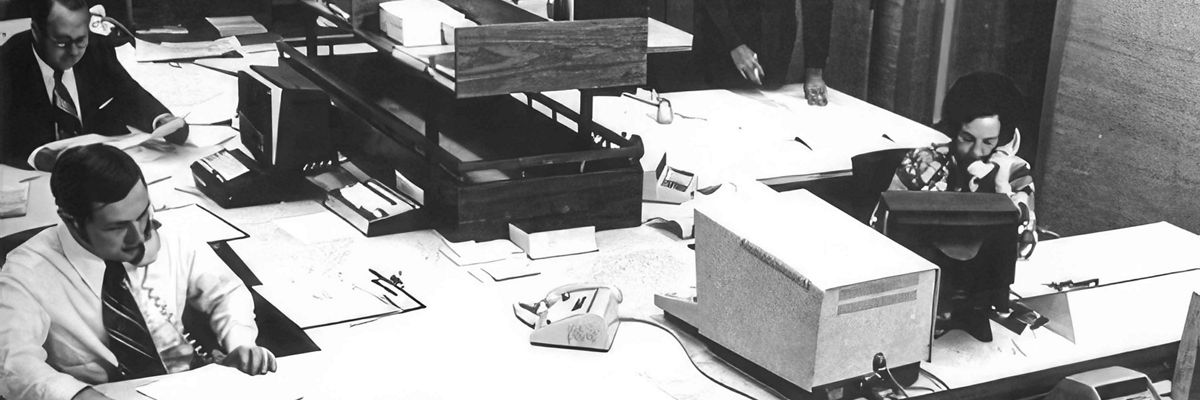
Wissen für Investoren: Die Gründung unserer eigenen Researchabteilung
Nach dem Börsenkrach 1929 wollte MFS, dass man der Fondsbranche wieder vertraut. Wichtig schienen uns dazu transparente Informationen und der Aufbau einer der ersten hauseigenen Analyseabteilungen.
Kurz nach dem Börsenkrach 1929 hatte die Große Depression die USA fest im Griff. Die Weltwirtschaftskrise war dadurch verschärft worden, dass Vertriebsmitarbeiter völlig haltlose Aktienempfehlungen verbreiteten – im Auftrag von Emittenten, die mehr an ihre Gewinne als an die Menschen dachten. Das Anlegervertrauen war ins Bodenlose gefallen. MFS hat in dieser Zeit jedoch gezeigt, dass für uns die Interessen unserer Kunden und Endanleger an erster Stelle stehen.
Weil wir unsere Verantwortung als Unternehmer ernst nehmen, entschlossen wir uns Anfang der 1930er-Jahre zu zwei Innovationen, die das Vertrauen in die Investmentbranche wiederherstellen sollten: Erstens sorgten wir für Transparenz durch Informationsaustausch, und zweitens bauten wir eine eigene Researchabteilung auf. Wir wollten die Unternehmen für unsere Portfolios genau kennenlernen.
Die Schlüsselperson war jemand, der seinen Kollegen immer wieder sagte, er sei kein „Investmentmann“. Merrill Griswold, der erste Chairman des MFS-Vorläufers Massachusetts Investors Trust (MIT), kannte aber die Menschen. Vor allem wusste er, wie man das Vertrauen zurückgewinnen konnte, das so viele nach dem Börsenkrach verloren hatten.1 Ihm war bewusst, dass enttäuschte Investoren wissen mussten, wie Investmentfirmen in ihrem Namen Kauf-, Verkaufs- und Halteentscheidungen treffen. Eine der ersten Initiativen von Griswold war „Goldfish Bowl“ – Berichte für Anteilseigner mit Informationen über Vertriebsgebühren, Finanzperformance und Portfolioveränderungen von MIT. Durch diese bis dahin beispiellose Transparenz behandelte er Anteilseigner wie Partner und – wichtiger noch – baute eine enge Beziehung zu ihnen auf.2, 3
Transparenz allein reicht aber nicht. Griswold wusste, dass Investoren dem Investmentprozess vertrauen müssen. Dazu mussten die Portfoliomanager alle Portfoliowerte wie ihre Westentasche kennen. Das ist aber nur mit eigenen Analysen möglich. 1932 gründete MFS daher eine eigene Researchabteilung mit dem Ziel, sich umfassend über die Emittenten zu informieren.

This unprecedented approach to transparency treated shareholders like partners and, more important, helped build stronger relationships with them.

Dwight P. Robinson, a brilliant Harvard-educated analyst was recruited to lead and run the department.4 Not only was he MFS’ first director of research, but he was also the first director of research in the industry. Both Robinson’s appointment and his approach were groundbreaking, as he engaged in a detective-like process, redefining what the industry considered fundamental research and placing a strong emphasis on statistical analysis.5 Robinson’s research department was built out with MFS’ first advisory board, so that together they could carefully scrutinize all investment opportunities to make the best possible decisions.
Early on, MFS recognized that being on-site and in person reveals just as much about a business as its balance sheet. Before committing any funds to an investment,6 there were visits to plants, factories and company headquarters, as well as meetings with senior management.
Robinson’s tactics of poring over financial statements and market reports and making analytical site visits continued with the next generations of MFS researchers. As David Antonelli, a research analyst who joined the firm in 1991 and went on to be equity CIO and vice chair, explained, “Our approach today remains a ‘bottom-up’ process that requires ‘kicking the tires’ of a company, regardless of market or location, and meeting with senior executives to ask ‘probing questions’ informed by expert, long-term investment analysis.”
What Robinson began not only catalyzed the building of MFS’ research department, it also became foundational to MFS’ active management philosophy — the necessity of understanding everything material about a portfolio company to determine whether or not it can create long-term value. Over the past 100 years, MFS’ teams of expert researchers have analyzed countless prospects, from early microwave technology in the US, to the viability of a grocery store chain in the UK to a Finnish cell phone innovator.7
A department that started with one fund in 1932 grew into a global research platform, fueled by the same purpose with which it began. “We really believe in our hearts and our souls,” said present-day MFS President and Head of Global Distribution Carol Geremia, “that we need to understand everything that we own with other people’s money. That’s why we committed to active management . . . and that’s why we have built the research platform that we have . . . because we want to get to the best information, the best idea that we possibly can, before we make an investment decision.”
Please note: Not all of the funds included in this material may be available for sale in your country.
Endnotes
2Wilson, Julia A. A Story of Progress: On the Twenty-Fifth Anniversary of Massachusetts Investors Trust. (1949) Massachusetts Investors Trust. Boston. Page 14.
3Wilson, page 14.
4Wilson, page 6.
5Wilson, page 13.
6Wilson, page 13.
7Wilson, page 9.